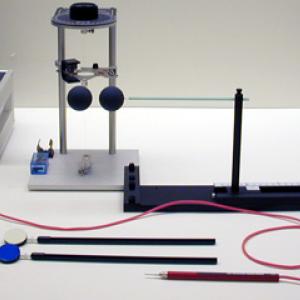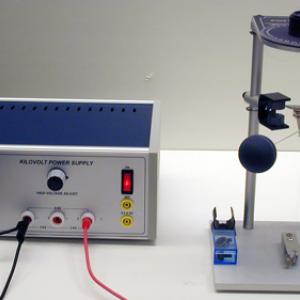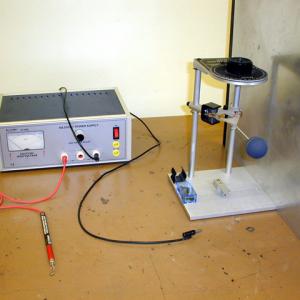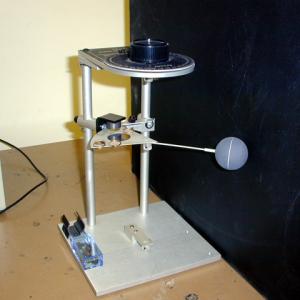College of Liberal Arts & Sciences
5A20.37 - Coulomb's Law Balance - Pasco Model
Zero the torsion pendulum before putting charge on the balls. Set the power supply at 5000 volts and touch one or both of the balls. Electrostatic repulsion or attraction can be shown and measured with this device.
An interesting variation is to use only the torsion balance part of the apparatus and a metal plate. When the ball is charged, a "mirror charge" will be induced on the plate. The ball on the torsion balance will swing over, touch the plate, then be repelled.
A discrepant event of the above demo is to use the black painted plate instead of the bare metal plate. In this case the ball will stick to the metal plate.
- Andrej Vidak, Iva Movre Sapic, Vladimir Dananic, Jadranko Batista, "Coulomb's Law: Augmented Reality Simulation", TPT, Vol. 61, #3, March 2023, p. 172.
- Peter F. Hinrichsen, "Comments on 'Letting Students Discover the Power, and the Limits, of Simple Models: Coulomb’s Law'", TPT, Vol. 57, #3, Mar. 2019, p. 132.
- Peter Bohacek, Matthew Vonk, Joseph Dill, and Emma Boehm, "Letting students discover the power, and the limits, of simple models: Coulombs law", TPT, Vol. 55, #6, Sept. 2017, p. 380.
- Subbho Banerjee, Kevin Andring, Desmond Campbell, John Janeski, Daniel Keedy, Sean Quinn, and Brent Hoffmeister, "Orbital Motion of Electrically Charged Microgravity", TPT, Vol. 46, #8, Nov. 2008, p. 460.
- Peretz D. Partensky and Michael B. Partensky, "Hanging by a Thread", TPT, Vol. 44, #2, Feb. 2006, p. 88.
- Michael Partensky and Peretz D. Partensky, "Can a Spring Beat the Charges?", TPT, Vol. 42, #8, Nov. 2004, p. 472.
- Peter Anderson, "A Wind Shield for the PASCO Coulomb Apparatus", TPT, Vol. 41, #1, Jan. 2003, p. 51.
- C. H. Worner, "On the Teaching of the Electric Dipole", TPT, Vol. 39, #8, Nov. 2001, p. 462.
- Robert Weinstock, "Two-Charge Dipole Revisited", TPT, Vol. 39, #4, Apr. 2001, p. 218.
- Christopher Bracikowski, "Graphical Analysis of Electric Fields of Dipoles and Bipoles", TPT, Vol. 38, #1, Jan. 2000, p. 20.
- Robert Weinstock, "Electric Field of a Two-Charge Dipole: A Graphical Approach Extended", TPT, Vol. 38, #7, Oct. 2000, p. 430.
- Leon M. Lederman, "Correction", TPT, Vol. 38, #9, Dec. 2000, p. 519.
- Adolf Cortel, "Demonstrations of Coulomb's Law with an Electronic Balance", TPT, Vol. 37, #7, Oct. 1999, p. 447.
- Scott W. Bonham, John S. Risley, and Wolfgang Christian, "Using Physlets to Teach Electrostatics", TPT, Vol. 37, #5, May 1999, p. 276.
- Robert J. Beichner, "Visualizing Potential Surfaces With A Spreadsheet", TPT, Vol. 35, #1, Feb. 1997, p. 95.
- MArcelo Alonso, "More on the Coulomb", TPT, Vol. 33, #6, Sept. 1995, p. 326.
- Sonya Cooper, Narasimha Prasad and Budh Ram, "Defining a Coulomb of Charge", TPT, Vol. 33, #4, Apr. 1995, p. 198.
- Josip Slisko and Arkady Krokin, "Physics or Fantasy?", TPT, Vol. 33, #4, Apr. 1995, p. 210.
- David T. Kagan, "The Ultimate "Pith Balls", TPT, Vol. 29, #4, Apr. 1991, p. 197.
- Samaroo Deonarine, "Coulomb's Law After the Christmas Party", TPT, Vol. 28, #9, Dec. 1990, p. 607.
- Donald Mahoney and Clifford Swartz, "What is the Potential at a Point Due to a Line Source?", TPT, Vol. 22, #6, Sept. 1984, p. 392.
- John B. Johnston, "Coulomb's Law on the Overhead Projector", TPT, Vol. 17, #1, Jan. 1979, p. 60, also A Potpourri of Physics Teaching - Electricity and Magnetism, p. 139.
- Russell Patera, "Stability of the Coulomb Balance", TPT, Vol. 16, #8, Nov. 1978, p. 565.
- Wijit Senghaphan and Richard K. Fry, "Current Balance & Coulomb's Law apparatus", TPT, Vol. 12, #7, Oct. 1974, p. 435.
- D. F. Bartlett and E. A. Phillips, "An Experimental Test of Coulomb's Law", TPT, Vol. 8, # 7, Oct. 1970, p. 403.
- Francis W. Sears, "A Substitute for Pith Balls and Balloons in the Demonstration of Electrical Forces", TPT, Vol. 1, #5, Nov. 1963, p. 225.
- Michael Levin, Steven G. Johnson, "Is the Electrostatic Force Between a Point Charge and a Neutral Metallic Object Always Attractive?", AJP, Vol. 79, #8, Aug. 2011, p. 843.
- Bernard Roulet, Michel Saint Jean, "Image Charges Revisited: Beyond Classical Electrostatics", AJP, Vol. 68, #4, Apr. 2000, p. 319.
- P. H. Wiley and W. L. Stutzman, "A Simple Experiment to Demonstrate Coulomb's Law", AJP, Vol. 46, #11, Nov. 1978, p. 1131.
- Curtiss O. Larson and Everett W. Goss, "A Coulomb's Law Balance Suitable for Physics Majors and Nonscience Students", AJP, Vol. 38, #11, Nov. 1970, p. 1349.
- Ronald Shaw, "Symmetry, Uniqueness, and the Coulomb Law Force", AJP, 33, #4, Apr. 1965, p. 300.
- Lawrie Challis and Fred Sheard, "The Green of Green Function", Physics Today, Vol. 56, #12, Dec. 2003, p. 42.
- David Kutliroff, "81, Coulomb's Law on an Overhead Projectors", 101 Classroom Demonstrations and Experiment For Teaching Physics, p. 179.
- W. Bolton, "Potential", Book 4 - Electricity, Physics Experiments and Projects, 1968, p. 24 - 25.
Disclaimer: These demonstrations are provided only for illustrative use by persons affiliated with The University of Iowa and only under the direction of a trained instructor or physicist. The University of Iowa is not responsible for demonstrations performed by those using their own equipment or who choose to use this reference material for their own purpose. The demonstrations included here are within the public domain and can be found in materials contained in libraries, bookstores, and through electronic sources. Performing all or any portion of any of these demonstrations, with or without revisions not depicted here entails inherent risks. These risks include, without limitation, bodily injury (and possibly death), including risks to health that may be temporary or permanent and that may exacerbate a pre-existing medical condition; and property loss or damage. Anyone performing any part of these demonstrations, even with revisions, knowingly and voluntarily assumes all risks associated with them.



